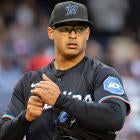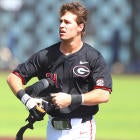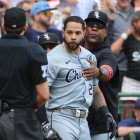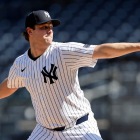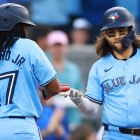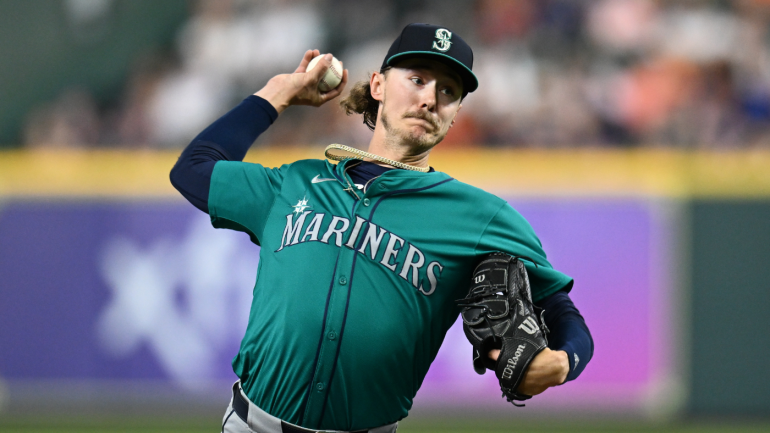
On Saturday, New York Yankees right-hander Luis Gil established a new franchise rookie record by striking out 14 batters in a victory against the Chicago White Sox. Gil's performance was well-timed in one respect: the pitcher who previously owned the record, Orlando Hernández (perhaps best remembered as "El Duque"), was in attendance to throw out the ceremonial first pitch.
Consider that a fitting development for Gil, whose continued presence in the Yankees rotation is something of a happy accident, too. Were it not for a springtime injury to Gerrit Cole, Gil would likely be slotted into New York's bullpen -- or, worse yet, the Triple-A rotation. Instead, he's taken nine turns in the Yankees rotation, and has fared well along the way. He enters Monday sporting a 2.39 ERA (164 ERA+) and a 2.30 strikeout-to-walk ratio. His estimated 1.5 Wins Above Replacement ranks No. 1 among American League rookie pitchers, edging Oakland Athletics closer Mason Miller.
Gil can credit his success to what's been a devastating three-pitch mix: a 96 mph fastball, a 91 mph changeup, and an 87 mph slider, all of which play hotter thanks to a deep release point. (He releases the ball around five inches farther than his 6-foot-2 stature predicts.) Each pitch has generated at least 30% whiffs this season, and none has surrendered an opponent's average better than .170. It's no wonder why he's been able to strike out more than 30% of the batters he's faced to date.
Luis Gil's 6th, 7th and 8th Ks. pic.twitter.com/Cj8HZt9H6Z
— Rob Friedman (@PitchingNinja) May 18, 2024
If there's an eggshell in Gil's batter, it's in the form of walks. He's demonstrated some of the worst control among big-league starting pitchers, entering Sunday with the second highest walk rate among qualified pitchers in the league at 13.6%, better than only Cleveland Guardians right-hander Triston McKenzie. So far, Gil has been able to make his extreme combination of strikeouts and walks work -- that's because he's done well in suppressing hard contact. He's surrendered three home runs in his first 49 innings, and he has the ball-tracking metrics to match. According to Statcast, Gil's 30.6% hard-hit rate (that is, percentage of balls with a 95-plus-mph exit velocity) ranks in the top 10 percentile.
Whether or not Gil can sustain such a tricky balance is to be determined. At minimum, it looks like he's going to force the Yankees to have some interesting conversations if and when Cole is ready to return to an otherwise stacked rotation. But Gil isn't the only young pitcher making noise (good or bad) across the majors. Below, we've highlighted four other arms worth monitoring.
1. Reese Olson, RHP, Detroit Tigers
Imagine being told a few summers ago that Detroit's second-best starting pitcher wouldn't be Casey Mize or Matt Manning, but the player they got back in the Daniel Norris trade. (For the well-adjusted folks in the crowd who can't recall said deal, the Tigers sent Norris to the Brewers for Olson at the 2021 deadline; it was not viewed at the time as a momentous occasion.)
Olson has since put together roughly a full season of big-league starts for the Tigers, amassing a 127 ERA+ and a 3.00 strikeout-to-walk ratio. He has a four-pitch arsenal: a mid-90s four-seamer, a mid-80s slider, a changeup, and a sinker; sometimes, he'll throw in a curveball against lefties to keep them honest.
Anyway, Olson is a throwback in this era of elevated pitches. He's located his four-seamer in the lower half of the zone more than 60% of the time, the highest rate among starting pitchers. He's also mastered placing his slider down and away and letting his changeup tumble beneath the zone. Those secondary pitches are the key to his arsenal. He's generated more than 40% whiffs on both, and they grade more favorably than his fastball variations when judged by the pitch-quality models.
Reese Olson's 2 1st Inning Ks. pic.twitter.com/G8FwcEk1bA
— Rob Friedman (@PitchingNinja) April 20, 2024
More important than how Olson does it is what he's done. Since a disastrous early-season start against the Pirates, he's reeled off a six-start stretch in which he's allowed two earned runs or fewer each time out. That span includes him blanking the Yankees and Marlins, and holding the Rangers, Twins, Royals, and Guardians to a combined five earned runs in 24 total innings.
The Tigers have to figure out their lineup if they're going to make the postseason for the first time since 2014. The rotation, on the other hand? That's all sorted. Just keep running Tarik Skubal, Olson, and their other starters out there.
2. José Soriano, RHP, Los Angeles Angels
The Angels, as a rule, don't have many bright spots to feel good about. Soriano is one of the exceptions. He opened the season in the bullpen, but quickly slotted into the rotation. In seven starts since, he's accumulated a 3.58 ERA and a strikeout-to-walk ratio a hair over 2.00.
Soriano took an unconventional path here. Obsessive readers will recall him as the top pick in the Rule 5 draft a few years back. (The Pirates later returned him to the Angels before he could even make a single regular-season appearance for the club.) Here's what we wrote at the time:
Soriano underwent Tommy John surgery last February. The missed season and elbow scar didn't repel the Pirates, who may even view it as a perk: the more time he misses because of his rehab, the less time they have to keep him on the active roster. When healthy, he has a hot fastball and a promising breaking ball that could play up in relief. Soriano's woeful command (more than five walks per nine innings as a professional) limits his ceiling.
A lot of that remains true. Soriano's fastball has averaged 99 mph this season, and his knuckle curve has generated a whiff rate north of 40% while serving as his primary offering. You might think we'd want to take back the comment about his command limiting his ceiling, but to some extent it's still relevant: his seasonal walk rate (12.1%) would rank as the fourth highest in MLB if he qualified.
José Soriano, K'ing the Side in the 4th.
— Rob Friedman (@PitchingNinja) May 8, 2024
6Ks thru 4. pic.twitter.com/ndEc4CnJhk
The catch is that, well, a lot of pitchers with walk issues are doing just fine these days. Four of the pitchers with the five highest walk rates this season have ERA of 3.33 or lower. That doesn't mean you should want your pitchers handing out free passes left and right; it does mean that there are worse fates than a base on balls, and that some skill sets appear capable of minimizing the damage.
Soriano, for his part, generates an extreme amount of ground balls and an above-average rate of double plays. We'd like to see more from him before we feel confident that he's built for the long haul as a starting pitcher, but it's probably fair to write that we sold him short a few winters ago.
3. Hunter Brown, RHP, Houston Astros
It wasn't too long ago that Brown was considered a quality prospect. He debuted in 2022 and caught eyes -- not only with some sharp performances out of the bullpen, but because his delivery looked similar to teammate Justin Verlander's. Unfortunately, his performances since have mirrored, not mimicked Verlander's performance. Over 40 appearances dating back to the beginning of last season, Brown has compiled a 73 ERA+ and surrendered 1.6 home runs for every nine innings.
Brown has fared a little better as of late: he entered May with an ERA nearing 10, but in three subsequent appearances he's posted a 4.40 ERA with more than two strikeouts per walk.
Hunter Brown's 3Ks in the 1st. pic.twitter.com/sEPxztXUvw
— Rob Friedman (@PitchingNinja) May 5, 2024
We wish there was one thing to point to and say, "this is the weak link in Brown's game." Right now, that's not possible. Batters have been hitting his four-seamer, hitting his curve, hitting his cutter, and hitting his slider. The only pitch among his five most-used offerings that hasn't surrendered an average over .300 is his splitter. That's a rough way to go about doing business.
To Brown's credit, he keeps experimenting to find the optimal pitch mix. For stretches this season, he's used each, the cutter, curve, and slider as his main secondary offering. He hasn't found the answer yet, but here's hoping that he's on the right track -- and that he can remind people, sooner rather than later, why he was once viewed as such a promising arm.
4. Bryce Miller, RHP, Seattle Mariners
Miller has been a big piece of a Mariners rotation that ranks top 10 in staff ERA. He enters Monday with a 3.08 ERA (120 ERA+) and a 3.25 strikeout-to-walk ratio over his first nine starts, ensuring that he continues to be a huge win for the Mariners' player development staff. Remember, Miller was a fourth-round pick coming out of college, having compiled a 4.45 ERA in his draft year.
Bryce Miller, 6th K thru 4 pic.twitter.com/ZcXYJHQbaM
— Rob Friedman (@PitchingNinja) April 30, 2024
Miller does most of his work with three pitches: a mid-90s four-seamer and sinker, as well as a low-80s splitter. He'll occasionally bust out a sweeper or a slider, but those three offerings account for more than 80% of his pitches thus far. The four-seamer, in particular, has been effective for Miller; he's generated a 31% whiff rate on his heater, one of the highest such rates among starters.
What makes Miller's fastball so hard to handle? The mid-90s velocity doesn't hurt. If we had to identify a single dynamic, however, we'd cheat and say it's the optical illusion created by the marriage between the pitch's innate rising action and his low release point. To put it into perspective, here's a complete list of pitchers with a release point lower than 70 inches whose fastball features more induced vertical break than Miller's 18.3 inches:
That's good company to keep. If you haven't watched a Miller start, make a point of doing it sometime this summer. Otherwise, your first exposure to him could be this postseason.














